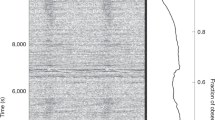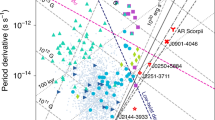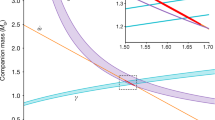Abstract
NEUTRON stars are usually born during the supernova explosion of a massive star. Any small asymmetry during the explosion can result in a substantial ‘kick’ velocity1 to the neutron star. Pulsars (rapidly rotating, magnetized neutron stars) have long been known to have high space velocities2,3, but new measurements of proper motion4–6, adoption of a new distance scale for the pulsars7 and the realization that some previous velocities were systematically low by a factor of 2 (ref. 8) have prompted us to reassess these velocities. Here, taking into account a strong selection effect that makes the observed velocities unrepresentative of those acquired at birth9, we arrive at a mean pulsar birth velocity of 450 ± 90 km s–1 This exceeds the escape velocity from binary systems, globular clusters and the Galaxy, and so will affect our understanding of the retention of neutron stars in these systems. Those neutron stars that are retained by the Milky Way will be distributed more isotropically than has been thought10–12, which may result in a distribution like that of the γ-ray burst sources.
This is a preview of subscription content, access via your institution
Access options
Subscribe to this journal
Receive 51 print issues and online access
$199.00 per year
only $3.90 per issue
Buy this article
- Purchase on Springer Link
- Instant access to full article PDF
Prices may be subject to local taxes which are calculated during checkout
Similar content being viewed by others
References
Woosley, S. E. The Origin and Evolution of Neutron Stars, (eds Helfand D. J. & Huang, J.-H.) 255–272 (Int. Astr. Un. Symp. 125, Reidel, Dordrecht, 1987).
Gunn, J. E. & Ostriker, J. P. Astrophys. J. 160, 979–1002 (1970).
Lyne, A. G., Anderson, B. & Salter, M. J. Mon. Not. R. astr. Soc. 201, 503–520 (1982).
Harrison, P. A., Lyne, A. G. & Anderson, B. Mon. Not. R. astr. Soc. 261, 113–124 (1993).
Bailes, M., Manchester, R. N., Kesteven, M. J., Norris, R. P. & Reynolds, J. E. Astrophys. J. 343, L53–L55 (1989).
Fomalont, E. B., Goss, W. M., Lyne, A. G., Manchester, R. N. & Justtanont, K. Mon. Not. R. astr. Soc. 258, 497–510 (1992).
Taylor, J. H. & Cordes, J. M. Astrophys. J. 411, 674–684 (1993).
Harrison, P. A. & Lyne, A. G. Mon. Not. R. astr. Soc. 265, 778–780 (1993).
Cordes, J. M. Astrophys. J. 311, 183–196 (1986).
Paczyński, B. Astrophys. J. 348, 485–494 (1990).
Frei, Z., Huang, X. & Paczyński, B. Astrophys. J. 384, 105–110 (1992).
Blaes, O. & Madau, P. Astrophys. J. 403, 690–705 (1993).
Lyne, A. G. & Smith, F. G. Nature 298, 825–827 (1982).
Fruchter, A. S. et al. Nature 331, 53–54 (1988).
Caraveo, P. A. Astrophys. J. 415, L111–L114 (1993).
Dewey, R. J. & Cordes, J. M. Astrophys. J. 321, 780–798 (1987).
Bailes, M. Astrophys. J. 342, 917–927 (1989).
Narayan, R. & Ostriker, J. P. Astrophys. J. 352, 222–246 (1990).
Bhattacharya, D., Wijers, R. A. M. J., Hartman, J. W. & Verbunt, F. Astr. Astrophys. 245, 198–212 (1992).
Lorimer, D. R., Bailes, M., Dewey, R. J. & Harrison, P. A. Mon. Not. R. astr. Soc. 263, 403–415 (1993).
Bhattacharya, D. & van den Heuvel, E. P. J. Phys. Rep. 203, 1–124 (1991).
Bailyn, C. D. & Grindlay, J. E. Astrophys. J. 353, 159–167 (1990).
Meegan, C. A. et al. Nature 355, 143–145 (1992).
Hartmann, D., Epstein, R. I. & Woosley, S. E. Astrophys. J. 348, 625–633 (1990).
Li, H. & Dermer, C. D. Nature 359, 514–516 (1992).
Author information
Authors and Affiliations
Rights and permissions
About this article
Cite this article
Lyne, A., Lorimer, D. High birth velocities of radio pulsars. Nature 369, 127–129 (1994). https://doi.org/10.1038/369127a0
Received:
Accepted:
Issue Date:
DOI: https://doi.org/10.1038/369127a0
This article is cited by
-
Scintillation Arc from FRB 20220912A
Science China Physics, Mechanics & Astronomy (2024)
-
Millisecond pulsars from accretion-induced collapse as the origin of the Galactic Centre gamma-ray excess signal
Nature Astronomy (2022)
-
A 62-minute orbital period black widow binary in a wide hierarchical triple
Nature (2022)
-
Evidence for three-dimensional spin–velocity alignment in a pulsar
Nature Astronomy (2021)
-
The Morphologies and Kinematics of Supernova Remnants
Space Science Reviews (2018)
Comments
By submitting a comment you agree to abide by our Terms and Community Guidelines. If you find something abusive or that does not comply with our terms or guidelines please flag it as inappropriate.



